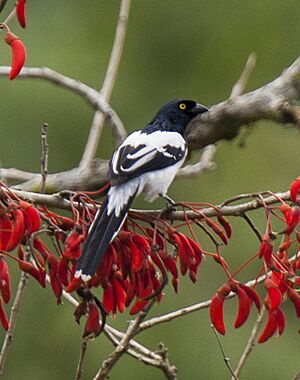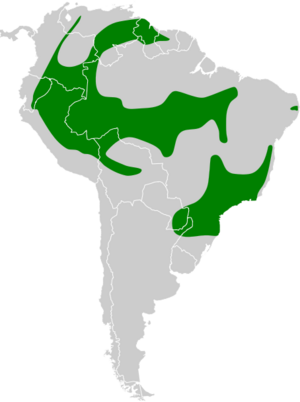Magpie tanager facts for kids
Quick facts for kids Magpie tanager |
|
|---|---|
 |
|
| at Manú National Park, Peru | |
| Conservation status | |
| Scientific classification | |
| Genus: |
Cissopis
|
| Species: |
leverianus
|
 |
|
| Synonyms | |
|
Lanius leverianus (protonym) |
|
The magpie tanager (Cissopis leverianus) is a cool bird from South America. It's a type of tanager, but it looks a lot like a European magpie because of its blue-black and white feathers. This bird is special because it's the only species in its group, called Cissopis.
It's also the longest tanager! A big part of its length, which is about 25–30 cm (10–12 in), is its long tail. It weighs about 69–76 grams (2.4–2.7 oz).
Contents
Where Magpie Tanagers Live
Magpie tanagers live in many places in South America, especially east of the Andes mountains. They like warm, wet areas like forests, farms, and even parks. You won't find them in very dry places.
These birds often live in parts of the forest that are more open, like near big rivers. They are even spreading into new areas where forests have been cleared, because this opens up the space they like. They usually stay in lower areas, but you can find them up to 2,000 meters (6,600 ft) high on the eastern slopes of the Andes. They are common in most of their homes, but a bit rarer in the Guianas.
Magpie Tanager Behavior and Diet
Magpie tanagers are quite noticeable! They often hang out in noisy pairs or in small groups of up to 10 birds. They sometimes join up with other types of birds to look for food together. You might see them moving their long tails up and down.
These birds eat a mix of things. Their diet includes seeds, fruits, and insects.
Reproduction and Nesting
When it's time to build a nest, the magpie tanager makes a cup-shaped home. They line it with soft materials like grass, leaves, or other plant bits. Their nests are usually low in trees or in bushes, hidden in thick plants.
Female magpie tanagers lay two eggs. The eggs are reddish-brown and have brown spots. Once the eggs are laid, it takes about 12–13 days for them to hatch.
Naming the Magpie Tanager
The magpie tanager was first officially described in 1788 by a German scientist named Johann Friedrich Gmelin. He gave it the scientific name Lanius leverianus.
Later, in 1816, a French scientist named Louis Pierre Vieillot created the group Cissopis just for this bird. The name Cissopis comes from ancient Greek words meaning "magpie" and "faced," which makes sense because it looks like a magpie! The second part of its scientific name, leverianus, honors an English collector named Ashton Lever.
There are two main types, or subspecies, of magpie tanagers:
- C. l. leverianus (Gmelin, JF, 1788) – This type is found from eastern Colombia and southern Venezuela, through the Guianas and the Amazon parts of Brazil, all the way to central Bolivia.
- C. l. major Cabanis, 1851 – This type lives in Paraguay, southeastern Brazil, and northeastern Argentina.


